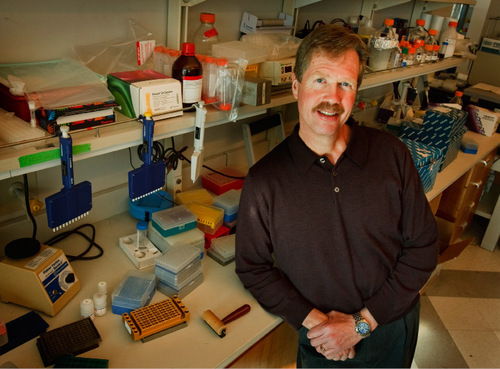This is an archived article that was published on sltrib.com in 2011, and information in the article may be outdated. It is provided only for personal research purposes and may not be reprinted.
In a subarctic forest 67 years ago, Soviet bullets cut down more than 100 Norwegians fighting for Nazi Germany, and left the bodies in remote woods where they remained for decades. A few years ago, the skeletal remains were recovered, but authorities have not been able to identify all these lost but not forgotten soldiers.
Now a new method of genetic analysis developed at the University of Utah is raising hopes they can be identified, along with perhaps thousands of other faceless victims of mass disasters, war and murder. The software enables researchers to determine whether any two people have a common ancestor as far back as great-great-grandparents, according to Lynn Jorde, who chairs the U.'s department of human genetics. He led a team of geneticists and other biomedical researchers at the U. in developing a process they call ERSA, which stands for estimation of recent shared ancestry.
"In mass disasters, whole families are lost so you don't have close relatives to compare someone's DNA to, only distant relatives," Jorde said. "Now that we can use genetic data to pick up distant relationships, we can expand the range of identification of missing persons."
Siblings share pieces of chromosomal segments. First cousins also share chromosomes, but in smaller pieces because they have to go back one more generation to find the common ancestor — in this case, grandparents. The new technology exploits recent breakthroughs in genomic sequencing that allow scientists to compare upward of a million areas of the genome, as opposed to the 15 or 20 under current methods.
"We count the number of shared chromosome segments and look at their size. The more closely related two people are, the larger the segments they will share because they are inherited from common ancestors," Jorde said. "We are able to determine the degree of relationship as distant as third, fourth, even fifth cousin."
Jorde and David Witherspoon, a post-doctoral research fellow in his lab, presented the research in October at the national meeting of the American Society for Human Genetics, of which Jorde is president. The work had been published earlier this year in the journal Genome Research, and more is forthcoming.
The genetic database compiled by Utah's Sorenson Molecular Genealogical Foundation advanced the research because it maintains pedigrees on thousands of people going back as many as 10 generations, along with their genetic samples.
"That is an extremely rare resource," Witherspoon said.
—
More potential uses • The U. is seeking to patent ERSA and license the technology to companies that do genealogical research. But ERSA has many potential uses outside forensics and genealogy. Researchers can shed new light on diseases that have a genetic trigger if they can establish ancestral connections between people who have a particular genetic disease, according to Witherspoon.
"We could narrow down in their DNA where that disease gene is," he said.
ERSA could even advance conservation biology by helping wildlife biologists figure out relationships between individual animals.
"If we can identify the cousinships, that could change the face of ecological research, but that's at least a decade way," Witherspoon said. "A long-standing question in evolution is how do related animals cooperate, or do they? There is a lot of cooperation in birds. The question is why would they bother? Under standard evolutionary theory, that doesn't make a lot of sense."
The International Commission on Missing Persons (ICMP), which was established in the mid-1990s to identify victims of Yugoslavia's bloody "ethnic cleansing" campaigns, approached Jorde to help identify the Norwegian soldiers whose bones were strewn around Russia's Kaprolat Hill.
"We have a really important society need and a clear technological solution," said Tom Parsons, the ICMP forensics director. Under current technology, the usefulness of DNA is limited because close family members are needed to provide samples. The Jorde lab technique expands the reach of DNA much further than sibling and parental relationships.
"This has huge implications for work at Katrina and World Trade Center," Parson said, referring to the disasters that killed thousands of Americans. But the technology's use for forensics remains limited. "It remains costly to get all the genetic data you would need, and it's difficult to acquire the data from degraded samples."
Meanwhile, the Kaprolat project is not without controversy since Germany occupied Norway during the war and many viewed the 15,000 men who donned Nazi uniforms in battle as traitors.
"Sixty years later there are no close relatives of these soldiers, so distant relatives are trying to match their DNA with these individuals to identify them," Jorde said.
The skeletons' teeth did yield DNA that was free of bacteria contamination, but researchers still face a technical hurdle. Over time, strands of DNA degrade into smaller pieces, so researchers must find a way to refine it before it can be accurately matched to samples from living relatives.
"We are working on that problem. There are several techniques," Witherspoon said. "It will go from impossible to matching to living relatives to being easy."
But the U. team has already confirmed that the technique works using samples from living people. They used it to draw family connections between populations whose DNA is archived in the Human Genome Diversity Project.
This means the process can be used to confirm family relationships claimed by people hoping to legally immigrate to United States, as well as confirm the pedigrees that are so crucial to biomedical research.
"Sometimes people who think they are related turn out not to be, and we need to know that to do genetic analysis properly," Jorde said.



